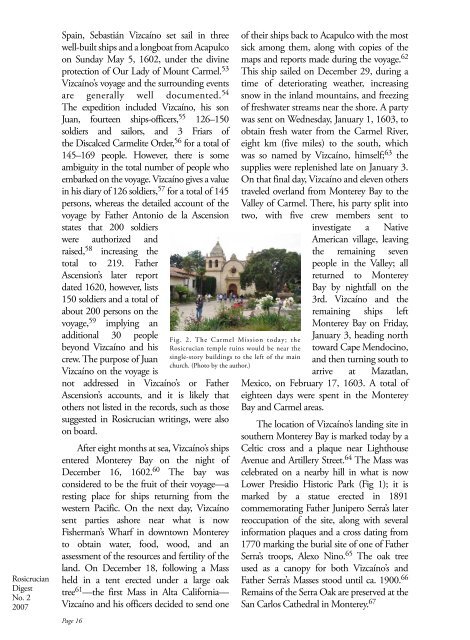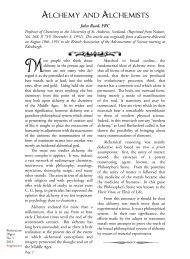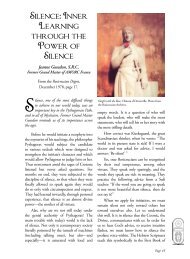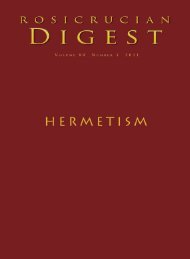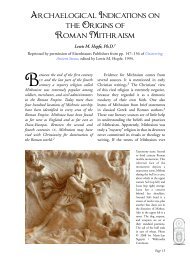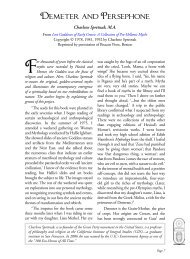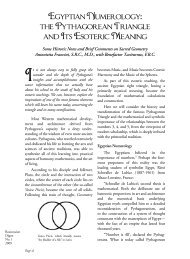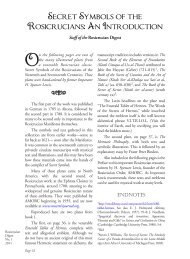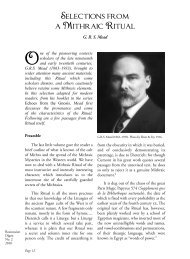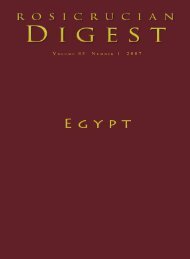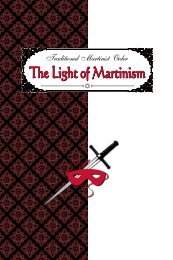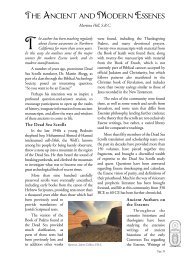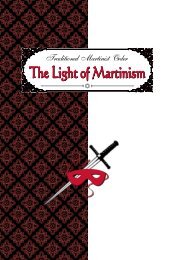Rosicrucian Digest Vol 85 Number 2 2007 - Rosicrucian Order
Rosicrucian Digest Vol 85 Number 2 2007 - Rosicrucian Order
Rosicrucian Digest Vol 85 Number 2 2007 - Rosicrucian Order
You also want an ePaper? Increase the reach of your titles
YUMPU automatically turns print PDFs into web optimized ePapers that Google loves.
<strong>Rosicrucian</strong><br />
<strong>Digest</strong><br />
No. 2<br />
<strong>2007</strong><br />
Spain, Sebastián Vizcaíno set sail in three<br />
well-built ships and a longboat from Acapulco<br />
on Sunday May 5, 1602, under the divine<br />
protection of Our Lady of Mount Carmel. 53<br />
Vizcaíno’s voyage and the surrounding events<br />
are generally well documented. 54<br />
The expedition included Vizcaíno, his son<br />
Juan, fourteen ships-officers, 55 126–150<br />
soldiers and sailors, and 3 Friars of<br />
the Discalced Carmelite <strong>Order</strong>, 56 for a total of<br />
145–169 people. However, there is some<br />
ambiguity in the total number of people who<br />
embarked on the voyage. Vizcaíno gives a value<br />
in his diary of 126 soldiers, 57 for a total of 145<br />
persons, whereas the detailed account of the<br />
voyage by Father Antonio de la Ascension<br />
states that 200 soldiers<br />
were authorized and<br />
raised, 58 increasing the<br />
total to 219. Father<br />
Ascension’s later report<br />
dated 1620, however, lists<br />
150 soldiers and a total of<br />
about 200 persons on the<br />
voyage, 59 implying an<br />
additional 30 people<br />
beyond Vizcaíno and his<br />
crew. The purpose of Juan<br />
Vizcaíno on the voyage is<br />
not addressed in Vizcaíno’s or Father<br />
Ascension’s accounts, and it is likely that<br />
others not listed in the records, such as those<br />
suggested in <strong>Rosicrucian</strong> writings, were also<br />
on board.<br />
After eight months at sea, Vizcaíno’s ships<br />
entered Monterey Bay on the night of<br />
December 16, 1602. 60 The bay was<br />
considered to be the fruit of their voyage—a<br />
resting place for ships returning from the<br />
western Pacific. On the next day, Vizcaíno<br />
sent parties ashore near what is now<br />
Fisherman’s Wharf in downtown Monterey<br />
to obtain water, food, wood, and an<br />
assessment of the resources and fertility of the<br />
land. On December 18, following a Mass<br />
held in a tent erected under a large oak<br />
tree 61 —the first Mass in Alta California—<br />
Vizcaíno and his officers decided to send one<br />
Page 16<br />
Fig. 2. The Carmel Mission today; the<br />
<strong>Rosicrucian</strong> temple ruins would be near the<br />
single-story buildings to the left of the main<br />
church. (Photo by the author.)<br />
of their ships back to Acapulco with the most<br />
sick among them, along with copies of the<br />
maps and reports made during the voyage. 62<br />
This ship sailed on December 29, during a<br />
time of deteriorating weather, increasing<br />
snow in the inland mountains, and freezing<br />
of freshwater streams near the shore. A party<br />
was sent on Wednesday, January 1, 1603, to<br />
obtain fresh water from the Carmel River,<br />
eight km (five miles) to the south, which<br />
was so named by Vizcaíno, himself; 63 the<br />
supplies were replenished late on January 3.<br />
On that final day, Vizcaíno and eleven others<br />
traveled overland from Monterey Bay to the<br />
Valley of Carmel. There, his party split into<br />
two, with five crew members sent to<br />
investigate a Native<br />
American village, leaving<br />
the remaining seven<br />
people in the Valley; all<br />
returned to Monterey<br />
Bay by nightfall on the<br />
3rd. Vizcaíno and the<br />
remaining ships left<br />
Monterey Bay on Friday,<br />
January 3, heading north<br />
toward Cape Mendocino,<br />
and then turning south to<br />
arrive at Mazatlan,<br />
Mexico, on February 17, 1603. A total of<br />
eighteen days were spent in the Monterey<br />
Bay and Carmel areas.<br />
The location of Vizcaíno’s landing site in<br />
southern Monterey Bay is marked today by a<br />
Celtic cross and a plaque near Lighthouse<br />
Avenue and Artillery Street. 64 The Mass was<br />
celebrated on a nearby hill in what is now<br />
Lower Presidio Historic Park (Fig 1); it is<br />
marked by a statue erected in 1891<br />
commemorating Father Junipero Serra’s later<br />
reoccupation of the site, along with several<br />
information plaques and a cross dating from<br />
1770 marking the burial site of one of Father<br />
Serra’s troops, Alexo Nino. 65 The oak tree<br />
used as a canopy for both Vizcaíno’s and<br />
Father Serra’s Masses stood until ca. 1900. 66<br />
Remains of the Serra Oak are preserved at the<br />
San Carlos Cathedral in Monterey. 67


